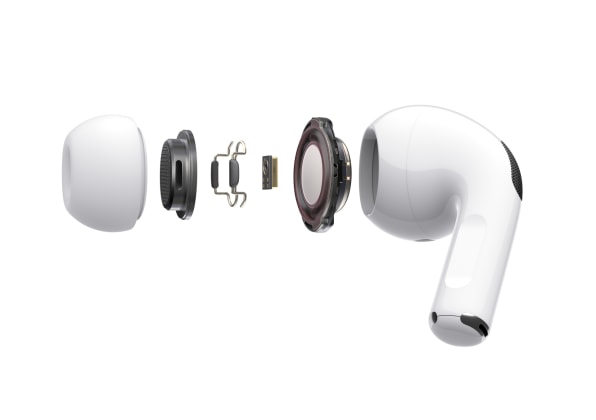The untold story of their creation
[ad_1]
For many years, folks have puzzled how Apple does it. How does the corporation innovate the way it does? How does it make this sort of insanely excellent goods that surprise and delight?
Couple people today know the struggle that it’s faced to get there. Like the good Michelangelo, Apple could possibly say, “If people realized how tricky I labored to obtain my mastery, it would not seem so excellent at all.”
When I joined Apple in 2015 as an HR company spouse, I marveled at the complex depth of its genius-amount engineers. There appeared to be no dilemma they could not solve. In a magical way, Apple experienced by some means brought together the ideal minds to produce the very best solutions in the environment. But over and above the concentrate on innovating, it experienced a elementary premise to the operate: secrecy. This is a benefit it held dear, to maintain the “surprise and delight” for consumers. The type that arrives on the day of launch when nobody (not even most workforce) anticipate how insanely terrific new solutions will be.
But this culture of secrecy experienced its dark sides. Hoarding of important information and facts. Pushing individual agendas. Infighting. As a new HR business enterprise husband or wife, I was frequently pulled into these escalations. And it was usually about “that team not sharing.”
I started off to question what this all intended. I’d listen to a single new employee after a further, fantastic individuals, inquiring the necessary query: “How do I work like this? If I can only share information with selected people today, how do I know who and when? I do not want to stop up fired or in jail.”
For all those who ended up new to the company—including the broad bulk of engineers—these dilemmas felt paralyzing. In the meantime, with the product or service ecosystem increasing and the technological troubles increasing, the want for collaboration grew. What to do, what to do?
I wrestled with this dilemma, looking everywhere you go for answers till I observed an interview at Startup Grind with Harvard Business University professor Clayton Christensen. The very same Clayton Christensen who’d created the reserve The Innovator’s Predicament, which experienced influenced Steve Jobs to crack the code of disrupting one’s individual corporation (believe iPad). The interviewer asked Christensen what he considered about Apple. He reported he nervous a large amount about a ton of businesses, like a mother problems sometimes. Then he explained he anxious particularly about Apple. But he mentioned that Apple would be just wonderful, if it could do this a person issue that Steve did: spend time staring in the mirror, primarily asking, “What do I have to have to do in a different way?”
This strike me tough. And it prompted this thought: “Yes. But what’s that mirror?”
Apple was a corporation that had traditionally innovated as small teams of engineers constructing extended-standing interactions. But situations experienced improved. The company’s rising workforce and scale of new persons in distinctive places amplified the demands for innovation to accelerate relationship, convergence, and collaboration. Secrecy was receiving in the way. And what we’d seen with the progress of AirPods was an illustration of specifically what would take place when we hadn’t solved for it. Groups ended up innovating for months in silos only to at last converge in the eleventh hour ahead of start, ending up in 5- or six-hour-prolonged each day conferences, causing remarkable friction and burnout. Men and women were being annoyed. They desired to leave or to “never perform with that a single person once more.”
If we have been to just take AirPods to the up coming amount, how could we do it in a additional seamless, romance-building way?
Customers really do not know all those at the rear of-the-scenes struggles of giving beginning to the AirPods just like most engineers who produced the AirPods did not know the AirPods would be these kinds of an explosively prosperous, meme-deserving products for the community, marketing millions, and generating an solely new classification. But at what price tag? And if we have been to take AirPods to the following stage, how could we do it in a much more seamless, romantic relationship-building way?

From Covey to Catmull
At this time, Ian Clawson—a pal turned organization partner—and I wrestled with the present-day climate of office cultures and the deficiencies observed in leadership development. We have generally experienced an affinity towards the ecosystem of timeless rules that Stephen Covey as soon as offered to the environment. We have been both of those drawn to his e-book, The 7 Patterns of Extremely Effective Persons, and the way its summary concentrated on synergy and interdependence—a refreshing change from self to selflessness.
Even though Covey motivated persons in their particular progress, we recognized co-generation doesn’t belong at the conclusion of the journey. Offered the worries cultures now experience, co-generation need to be entrance and centre. We also realized that we did not want to grow to be self-help gurus, but guides to help people today bravely converge timeless concepts with lifestyle.
Right here was a performing braintrust that perhaps we could expand and scale across Apple.
We’ve also been captivated by this notion of the braintrust that Ed Catmull, founder of Pixar, shares in his ebook, Creativity, Inc. Most persons experience they do not have creative license to make choices at get the job done, or the capacity to lead without express authorization. While Pixar is a inventive manufacturer, it gives a template for channeling collective genius by encouraging the creative voice. Why do not other businesses do this? Most function cultures are loaded with forms and politics that squash creativity at to start with sight. The solution: Blending timeless concepts and creativity—to encourage co-generation.
At the main, we wondered: What could concepts tied to co-generation do to enable bridge these silos observed in organizations like Apple?
Probably this was our “garage build minute,” similar to what Steve Jobs and Steve Wozniak will have to have skilled when they started Apple. We have been faced with the burden of making an attempt to recognize problems rising in place of work cultures. We each were being at a point in our careers the place we could be courageous sufficient to determine out answers. We knew that a leader could not control what a tradition results in being, but we also observed that individuals can impact and add to culture.
How could Apple have avoided the internal turmoil we confronted with the progress of AirPods? How do cultures consider the form they do? These queries and the inspired sessions with Ian, led me to form a mini braintrust at Apple. As a little grou
p of HR companions, we began to explore this by obtaining curious about the Apple society. When we unpacked it all, we started inquiring further, existential thoughts: Which leaders and teams innovate and collaborate very best, and why?
We collected a small list of folks and sought to comprehend the features that were being key to their achievement. Men and women in components. Software package. Functions. We observed a braintrust in the digicam crew that was a potent example of collaboration. But no a single exterior of that group seemed to know much about it. It fascinated me that there was a braintrust, considering that I’d occur from Disney and witnessed the electricity of Ed Catmull’s idea at Pixar of the braintrust—a collective team committed to “egos off the table, making blocks on the desk.” Most individuals have listened to that Steve Positions had impacted Pixar, which he did. But in this article was an perception we hadn’t regarded as: Ed Catmull and Pixar experienced influenced Apple tradition in a essential way. And, right here was a doing the job braintrust that perhaps we could broaden and scale throughout Apple. But what created it get the job done and why? What have been all those essential ingredients we could share?
Openness in a closed system
As we met leaders, what we observed astonished us. When Apple was so evidently delineating secrecy as a elementary worth to the business, powering the scenes just about every of these leaders have been highlighting the electric power of the one detail that created them effective: sharing. Priya Balasubramaniam in functions talked about it, emphasizing the will need to share early with many others. Angela Ahrendts in retail talked about it. Jony Ive’s industrial layout group talked about it. Mattia Pascolini’s wi-fi style and design workforce also introduced it to lifestyle. And Lynn Youngs, head of show, touch, and digital camera know-how, shared this about how he applied sharing: “I come to the table with my ideas, and they arrive to the desk with theirs. If we take into account ideas ‘our young ones,’ I have to treatment as a great deal or extra about ‘their kids’ as I do about mine for one thing magical to occur. And which is authentic sharing. That’s innovation.”
Of program, not a one leader advised heading intense in sharing, like Silicon Valley businesses that unfold product or service roadmaps to the community. That would spoil the shock. But what we identified was a stage of openness in a famously shut technique that included significantly a lot more sharing than any person was chatting about, and considerably a lot more than new workforce understood.
Aspect of this work involved partnering with men and women like Randy Nelson at Apple College, the exact person who’d launched Pixar College. His sights on the electrical power of sharing and collaboration, like Ed Catmull prompt in the reserve Creative imagination, Inc., ended up important to hard assumptions of what could be shared at Apple.
Indeed, sharing could be performed in the context of secrecy.
We also met with Ed Catmull himself, to broaden the electricity of the braintrust. By then he was “Jedi-fading” out of Disney and Pixar into retirement, having established cultures of innovation by way of braintrust. He even instructed us that he was proud that not only was the Braintrust a meeting at Pixar, but also that it experienced turn into ingrained throughout the complete society. This grew to become our aspiration for Apple: What if the braintrust had been infused everywhere in their DNA? What if we used it to AirPods? They were the variety of business that could do it. But it would consider a large amount of perform.
We found “The Digicam Braintrust” (as in Iphone camera, or the cameras in any hardware devices), or “CBT,” and applied these key ingredients: a weekly cross-staff members transparency session, focusing on a susceptible or open up technique to sharing challenges they ended up facing. Just about every chief and team with a voice, each sharing particularly wherever they ended up in their improvement, and what they necessary from the other groups. This led to cycles of innovation that experienced accelerated the camera technological innovation to new heights, generating it the gold normal of collaboration.
When we noticed how nicely the Digital camera Braintrust was doing the job there, we puzzled what would happen if we used that same strategy to the following iteration of AirPods: common cross-employees sessions, transparency, and shared voice. What occurred future was incredible: As teams converged with leaders becoming extra open, connected, and driving higher top quality collaboration than at any time ahead of. We spent time coaching, collaborating, and influencing critical leaders and engineers driving the subsequent frontier of AirPods. What emerged was a braintrust with standard classes, openness, and connection that introduced to daily life the insanely terrific, sounds-canceling AirPods Professional. It was a testament to innovation, but also to the energy of sharing. Of course, sharing could be done in the context of secrecy.
Subsequent, we wondered, what if we expand this notion of braintrust just about everywhere else at Apple? We then brought this concept of Collaboration by Style to all of R&D at Apple. We shared it with the retail tactic group. And a little something distinctive took place: Further collaboration and convergence on Apple View, PowerBeats Professional, MacBook, and iterations of Iphone. Leaders who seemed caught on previous strategies of sharing have been adapting. They ended up continue to considerate, but sharing a lot more freely in circles across capabilities, by design and style, somewhat than avoiding it by default.
What emerged was a society shift to what we termed “Different With each other,” the future-amount idea for Apple’s upcoming. Combining the electricity of the historic definition of “Think Various,” which highlighted the strength of infinite range in voices, with the ability of performing it all “Together.” All of this is enabled by currently being improved at sharing.
What will Apple’s culture reach subsequent? Who appreciates. But the firm is heading into a future wherever it’s considerably superior organized to innovate with co-creative braintrusting teams, even in hard contexts like distributed workforces resulting from COVID-19. Now Apple can carry on with collective self-confidence as it hits the fuel on innovation—because “Different Together” now usually means the tradition at Apple is building a difference alongside one another.
Hunting back, throughout that time at Apple (which we consider our “beta test” for cracking the code on tradition transformation), we believed co-creation can be used to any domain. Now, we’ve zoomed out to talk to the thoughts: How can any organization completely transform its lifestyle (in particular when a large amount is doing the job presently)? How do they break from cultural norms keeping them back from shaping the long run at the subsequent level? These are the themes we continue to investigate at our new consultancy, BraveCore.
Now that AI can do what knowledge employees have done in the earlier, the world is at a tipping level. The future belongs to the brave types who can unleash the ability of co-generation in their lifestyle.
Along with Ian Clawson, Chris Deaver is cofounder of BraveCore, a management consultancy that can help leaders be more innovative and creatives be far better leaders. In earlier roles, he’s shaped tradition transformation inside of Apple and Disney.
[ad_2]
Supply url








